CNC Machining Guide: Working with a Manufacturer to Machine Your Components
The team at Modus Advanced has put together this guide to CNC Machining to help you understand when to use CNC machining, how the manufacturing process works, and how to assess potential partners.
Or scroll to read the entire guide below.
%20(1).png)
DON'T HAVE TIME TO READ THEENTIRE GUIDE NOW?
We'll email you a downloadable PDF version of the guide and you can read it later.
CNC machining is a mainstay of our modern manufacturing ecosystem. It’s used to manufacture all kinds of products across a wide variety of industries that touch our lives every day. Everything from handheld communication devices, to life-saving medical devices, and even aerospace components in rockets and missiles.
Without the development of CNC machining processes and technologies, our modern world would simply look — and function — nothing like it does today. The advent of CNC machining changed the manufacturing industry forever, evolving it from manual, labor-intensive processes to an automated, computer-powered approach with the capacity to reliably produce high-quality products at scale.
CNC machining services exist all around the world. But picking the best CNC machining partner for your business requires a considerate amount of thought. After all, regardless of your industry, quality matters: for your business, your customers, and your reputation.
Before you select a CNC machining partner, it’s vital you understand when to use CNC machining, how the manufacturing process works, and how to assess potential partners.
Fortunately, you’re in exactly the right place. This comprehensive guide, put together by the team at Modus Advanced, covers all that and more. Read on to discover everything you need to know about CNC machining and working with a manufacturer to machine your components.
Table of Contents
What Is CNC Machining?
Computerized Numerical Control Machining, referred to as CNC machining, is a computerized manufacturing process–long gone are the days of manual machining. It uses pre-programmed software to precisely control the movement of various types of production equipment and produce a wide variety of intricate metal and plastic components.
The process begins with using computer-aided design (CAD) software, in which the design is created. It is then translated to a format the CNC machine's computer can understand. Machinists ensure that the design fits within the capabilities of the machine and the material. The machinist then programs the CNC machine to produce the product based on the design.
CNC machining is one of the widest and most diverse categories of manufacturing there is. It can be used to mass produce simple components or to produce low volumes of highly complex designs. Typical machine shops tend to excel in very specific areas of CNC machining. Modus Advanced is particularly well suited for manufacturing RF shields with EMI shielding gaskets, RF absorbers and thermal pads. These projects are complex in nature, require concurrent processes, and precision designs.
What Industries Need CNC Machined Parts?
CNC machining is suitable for all kinds of industries. Since it is used to create highly intricate and to-spec parts, industries that need custom parts are more likely to use this technology. Thanks to the advancement of CNC machining technology, it allows for highly complex and customized designs which other manufacturing processes cannot match.
Companies in industries such as aerospace and defense, and medical device manufacturers require perfection and the highest level of accuracy in their parts because “almost perfect” could put lives at risk. Additionally, industries that require a variety of tolerances and materials can also benefit from CNC machining.
How to Choose the rightCNC Manufacturing Partner for Your Needs
Choosing the right CNC manufacturing partner starts with the very obvious question: “What kind of part do you need CNC machined?” Different types of CNC machining manufacturers typically have projects they are best suited for and this sets the entire trajectory of the CNC machining “choose your own adventure” book.
Here are a few questions to ask yourself to weed out the machine shops that might not fit the bill:
Are your parts simple or complex?
Small, simple, repeatable parts are likely safe with several different manufacturers. As long as they support small enough volumes for the prototyping phase, you shouldn’t have an issue finding a suitable partner.
Complex parts, machined RF shields, or metal housings that will require the application of additional manufacturing processes such as form-in-place gaskets are entirely different animals. (You’ll need a specialist, like Modus Advanced, for that one.)
If your part is complex, you’ll want to find a specialist rather than a generalist. Ensure your potential partner has the appropriate quality and security certifications, a team with plenty of engineers on staff, and the willingness to work through an iterative prototyping process with you.
What material do you need to use?
From the highest level, Modus Advanced can machine both metal and plastic parts. The most common material we see used for machined parts is 6061 aluminum. Most machining partners will be able to handle that without an issue. If your part requires specialized material, make sure your potential partner knows how to handle it, and has a proven track record machining it.
What are your tolerance requirements?
Tolerances in the aerospace and defense industries are non-negotiable. Your machining partner should have both the skill and the equipment to maintain (and measure) your tolerance requirements.
Are there concurrent manufacturing processes that will be run on the CNC machined part?
If your part requires additional manufacturing processes, it is wise to look for a CNC machining partner who is vertically integrated and can handle the additional processes with expertise. Enlisting a single vendor who can do this can ensure that your part is done right the first time.
As a vertically integrated manufacturer, Modus in-house manufacturing processes include CNC machining, application of platings or coatings, form-in-place (FIP) gasket dispensing, and the application of thermal materials and RF absorbers.
Do you have complex geometries or strict flatness requirements?
Complexity drives the level of expertise required from your potential CNC machining partner. Make sure if you have these requirements to discuss them with your potential partner ahead of time, and ask for a record of past performance in hitting those requirements.
How fast do you need the parts?
Prototyping, for example, requires quick turn parts at low volume. Many CNC machining partners are not well suited to do prototype work simply because it takes them so long to turn parts around.
We, at Modus Advanced, are best suited to work with OEMs on quick-turn prototype and production work, given our investments in equipment, automation, technology, systems and people. Our investments allow us to stay nimble and move quickly.
Do you need design feedback?
Every design can use the benefit of a good review and strategic Design-for-Manufacturability (DFM) feedback. Not all manufacturing partners offer this service, however, it is a benchmark of true partnership.
We can provide expert guidance on design features that will help reduce the time it takes to produce a machined shield as well as the total cost.
Final Considerations on Choosing the Right CNC Machining Partner
This list isn’t exhaustive, however, it gives you a great launching point. Choosing the right CNC manufacturing partner for your project comes down to how complex your project is.
How to Work with a Manufacturing Partner to Get a CNC Machined Component
We’ve found that there are plenty of misconceptions about the process of bringing a machined part to life. That’s why we have a well-structured Design-for-Manufacturability (DFM) process that we adhere to (and how we believe it should work anywhere).
To start, gather the necessary information that your manufacturing partner might need. This includes the design, material selection, requirements for turnaround time, and the volume of parts needed (both in Prototype and Production situations). Your manufacturing partner should be involved as early in the design process if possible, as they can lend valuable feedback reducing the amount of time spent reworking a design.
Next, our engineers review the design and provide you with feedback so that you can review and update the design if needed. It isn’t uncommon for us to receive orders for parts that cannot be made according to the specifications outlined in the design. Here are some of the most common reasons:
- Material tolerances for gaskets
- Drawing issues for machined parts
- CAD issues
- Modeling issues
As we review the drawings for the part in question, we ensure that it is possible to produce the part while also looking for potential changes that can make it less complex to manufacture. We typically look for specifications that would require lengthy or expensive methods for production. Many times, the design can be changed to reduce costs and lead times without wavering on quality or impacting the functional requirements.
Learn More About the SigShield™ Process
Often when manufacturing a product that requires the dispensing of form-in-place gasket, it pays to have a partner who can machine your housing, dispense FIP gaskets, and manufacture other components under one roof.
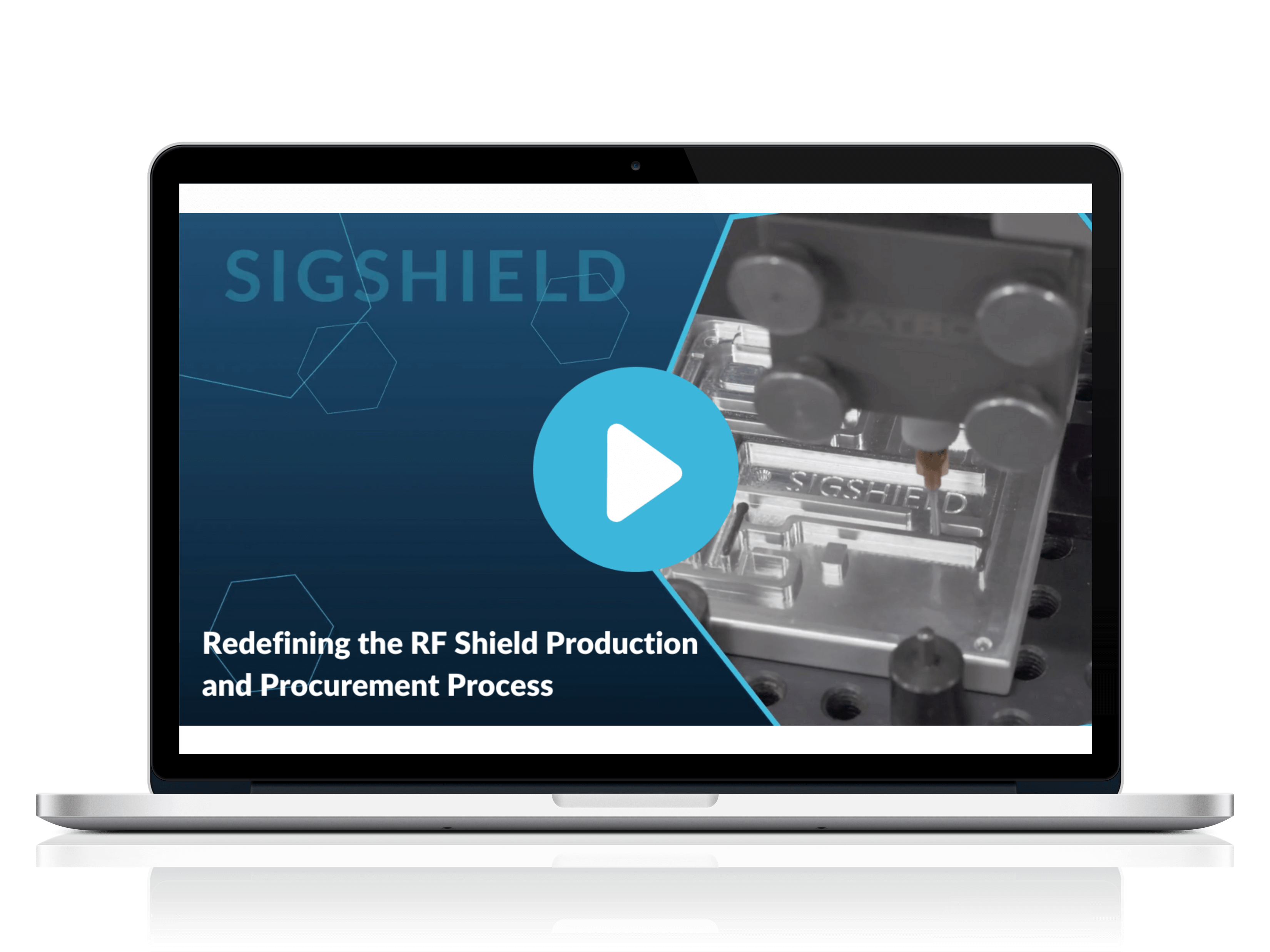
Working with a Vertically Integrated Partner forCNC Machined Parts
As we mentioned earlier, working with a vertically integrated partner is a big bonus all around if you are designing a part that requires concurrent processes. Vertical integration is uncommon in RF shield manufacturing, for example, but it provides big benefits.
At Modus, we take four concurrent processes and tackle them all under one roof, all captured in our proprietary SigShield™ process. When we can control every aspect of the manufacturing process, from start to finish, we are better able to control quality. We saw a need for more-quality control, decreased lead times, and decreased cost, so we created a robust solution that answered the call.
Being vertically integrated means that the quote for our turn-key SigShield™ product covers four times more than most other quotes you see for RF shields. While you may be comparing quotes to other vendors who are quoting single steps in the process, we’ve streamlined the entire production process. This means half the lead time, a quarter of the freight cost, and 100% fewer headaches.
Interested yet? Let’s dig into what the process of creating your CNC machined parts with a vertically integrated partner looks like.
Machining and Metal Housing
We start by CNC machining your metal housing according to your design requirements. If this is our first time running a part, it typically takes upward of a week to set everything up properly. Once the part is ready to run, the machining can be done in a matter of a few days depending on the complexity and capacity.
One of the reasons SigShield™ was born was because we regularly saw issues with the CNC machined housing that wasn’t up to quality standards. We had to send it back to the previous vendor for fixes before we could begin the process of form-in-place gasket dispensing. This halted a project before we could even get it off the ground, costing more money and causing huge headaches for our customers.
Plating and Coating
Once your housing has been machined, we’ll apply the required platings or coatings as specified in your design. Additionally, after plating, we are able to add any inserts that you may require for your particular part, including helicoils, dowel pins, and keenserts, etc.
At this phase, we send the part through 100% inspection to make sure no detail has been overlooked. When it passes inspection, we move on to the gaskets.
Form-in-Place (FIP) Gasket Dispensing
Once the machining and plating are completed, we do an internal inspection before moving it directly to FIP dispensing. Because we already have everything we need during the machining process, we can be programming the FIP dispensing machines while CNC machining is in progress. This means that when we shift gears to dispensing form-in-place gaskets, it only takes us a couple of days to complete.
Addition of Thermal Materials and/or RF Absorbers
In parallel with machining and FIP dispensing, we can manufacture thermal materials and/or microwave absorbers to apply to your part before shipping. A separate Modus team is tasked with making any thermal or microwave absorbers required for your RF shield. As soon as the FIP gaskets are done curing, we can apply the absorbers and thermal pads.
Quality Inspections
We do detailed quality inspections, that are built to adhere to your standards, between each step in the process and before the final part is shipped to you. Once each of the required processes mentioned above are completed, the only remaining step is quality inspection. Once the RF shield is complete and inspected, we pass it back to you 100% complete.
Final Shipping
The SigShield™ process usually takes around 4-6 weeks depending upon part complexity, and order volume. In cases where our customers have needed speed, we have been able to deliver in as little as 2 weeks in total, but several factors drive this tight timeline.
1/4 the Freight Cost
The traditional method involves shipping at least four times throughout the process (once between each manufacturing step). Customers often ship the product back to their facility to complete an inspection between each step, which means you are shipping parts upwards of eight times across the life of the process.
With SigShield™ you pay for shipping one time, at the end of your project. This means that you are saving at minimum 1/4 of the freight cost and potentially up to 1/8 of the freight cost over the total life of production.
100% Fewer Headaches
By utilizing a vertically integrated manufacturing partner like Modus Advanced, you can expect to avoid issues like:
- CNC machined housing that wasn’t up to quality standards, and thus had to be sent back to the previous vendor for fixes before the process of form-in-place gasket dispensing could begin.
- Missed deadlines by one of the vendors in the process, throwing off the production schedule for all the following vendors in the chain, significantly increasing lead times.
- Miscommunications between vendors, or bottlenecks in communications as you, the customer, have to manage all the moving pieces between vendors.
The passing back and forth leaves a lot of room for error. A single error can mean part failure and sends you back to the drawing board. This screams inefficiency, and by working with a high-quality vertically integrated manufacturing partner, you can avoid these headaches altogether.
Platings and Coatings
After the CNC machining of your part, platings and/or coatings are applied if specified in your design. With our SigShield™ process, we see these requirements quite often. These two treatments offer additional protective layers to your CNC machined part. While sometimes used interchangeably, platings and coatings are two different processes.
Coatings refer specifically to chemical conversion coatings, which is a chemical reaction that gives a superficial layer that contains a metal compound. The most common request for coatings we see includes the military specification MIL-DTL-5441 specification, type II, class 3, which indicates a request for chemical conversion coatings that contain no hexavalent chromium and provide protection against corrosion, whether painted or unpainted. Typically, the execution of this process can add 1-2 weeks to your lead time.
Platings, on the other hand, are the addition of material, typically electroless nickel, to the exterior of the part to enhance hardness, wear, and corrosion protection. Plating is also a common requirement for the RF shields we manufacture through our SigShield process–on its own or in concert with coating. In this case, the request will typically state that threaded holes are to be conversion coated and the rest of the part is to be plated with electroless nickel. This combined process of coatings and platings can add upwards of 2-3 weeks in lead time.
FIP Gasket Dispensing
Form-in-place (FIP) dispensing is among the most common and effective ways to manufacture gaskets for use in RF and EMI shields. In FIP dispensing, a liquefied gasket material is dispensed onto metal or plastic housing, and the material then dries and cures to the housing. The liquid gasket fills only the space it needs to, and then it is cured either by heat, light, or moisture causing the material to form in place. When compared to die-cut gaskets, FIP gaskets reduce waste and, ultimately, result in cost savings.
You can find FIP gaskets in nearly every industry, but some of the industries that rely on these gaskets the most include the following:
- Military and defense
- Communications
- Electronics
- Aerospace
- Medical devices
FIP gaskets are popular in these industries for many reasons, but precision, durability, and flexibility are at the top of the list. The most common FIP gasket materials include silicone, fluorosilicone, and synthetic rubber. Each of these materials offers unique strengths for particular applications.
Additionally, FIP gaskets can be electrically conductive if needed, and there are many filler materials you could use such as silver, nickel, copper, graphite, aluminum, and ferrite. The filler material, or combination of fillers, you choose for your FIP gasket will depend on the device’s needs and the project budget.
In general, FIP dispensing may be a good choice for the following situations:
- Small, complex, and intricate parts
- EMI and RF shielding
- Environmental sealing for dust or water protection
- Resistance to freezing, heat, UV, and corrosion
- Fast assembly or short turnaround time requirements
Situations where installation of the gasket is very difficult or would be made easier if the gasket were adhered to the part surface.
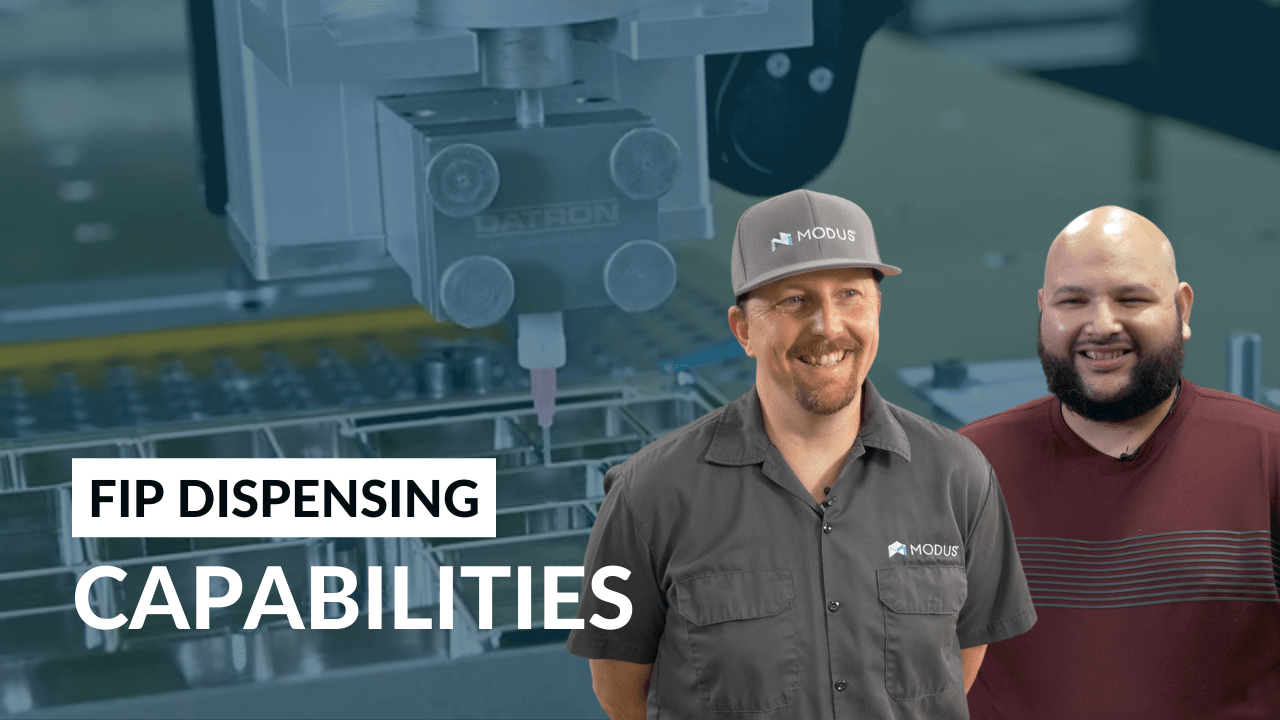
Die Cutting
Die cutting is an option for manufacturing thermal materials or RF absorbers that are commonly used on RF shields. In general, it is the standard method of choice for two-dimensional gaskets or materials being produced at high volumes. Flatbed die cutting uses steel rule dies, solid milled dies, and male/female or compound dies to cut or punch sheets of gasket material.
To die cut parts, you must first build the die which usually costs somewhere between $300-$700, and then pay for the production of parts. This typically isn’t ideal for the prototyping phase, where only a few parts are required and the design itself may still change.
Die cutting might be a good fit if the following are true:
- The shape of the material being cut isn’t very intricate
- The thermal material or absorber doesn’t have very narrow walls
- The material to be converted isn’t larger than the size of the die press
- The material you are cutting isn’t too thick
- You have a lead time of over a week (for hard tooling to arrive)
Depending on your particular circumstances, die cutting may be the right option for manufacturing the thermal materials and absorbers going into your finished component. Going through the Design-for-Manufacturability (DFM) process will help provide additional viewpoints that you may not have considered in manufacturing your gaskets.
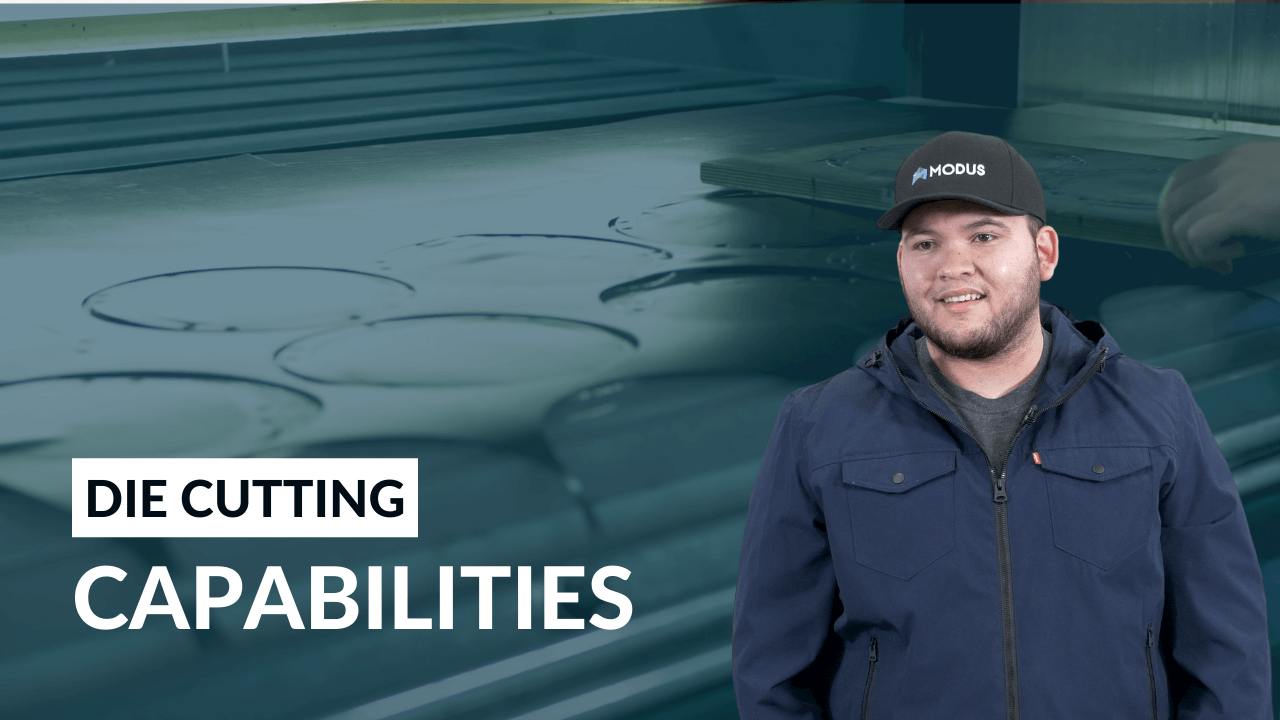
CNC Cutting
CNC cutting, also called digital cutting, uses a very precise knife to cut the thermal or RF absorbing material. With this method, the design file is uploaded into a computer that is controlling the cutting tool. Referencing the digital file, the machine runs the cutting tool and produces as many parts as you have programmed to cut.
Typically, two cutting implements can be used: a drag knife and a pneumatic oscillating knife.
The drag knife works exactly the way you’d expect it to, where it is inserted into the material and dragged across the cutting path to produce the part.
The pneumatic oscillating knife works in an up-and-down fashion to cut through the material, is lifted, then shifted forward, and pressed through again.
In general, CNC cutting may be a good choice for the following situations:
- Rapid prototyping: no hard tooling means small volumes can be produced quickly and less expensively than methods that require hard tooling
- Material waste: designs that nest well can provide less material waste than die cutting and may help reduce your material cost
- Handles small or large parts well: great for parts that aren’t a fit for die cutting because they are too small or narrow, or are too large for the die press
- Short lead times: if you need your parts faster than hard tooling solutions can turn them around, CNC cutting may be the right fit
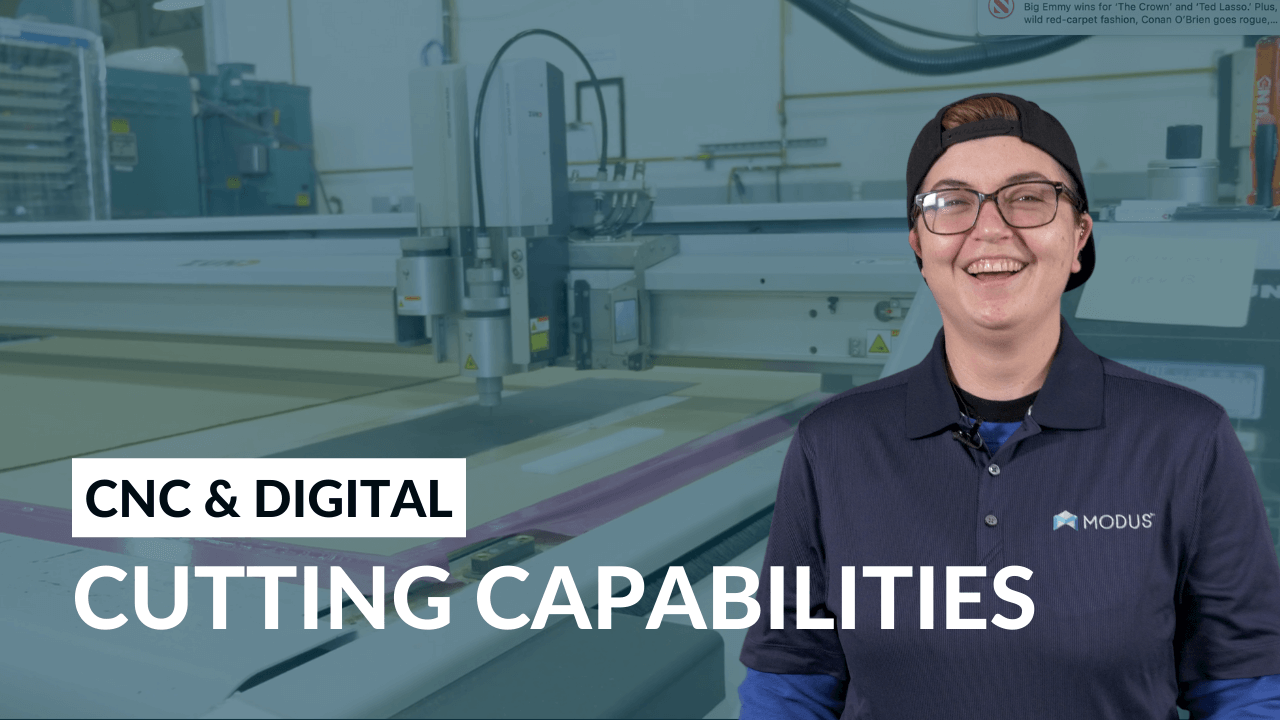
Waterjet Cutting
Waterjet cutting is most often used for creating two-dimensional gaskets or to cut thermal materials or RF absorbers out of thicker and/or harder material. It works by using a high-powered stream of water (try 94K psi) to cut through some pretty tough materials. Mix in <.040” garnet into the stream and you can cut through 6” stainless steel, which is pretty amazing.
Waterjet cutting is a form of computer numerically controlled equipment, it can cut very precise lines, smooth edges, and corners. It also means there are no hard tooling requirements for using waterjet. Because the waterjet has 8 unique heads that can all be cutting parts at the same time, it can handle a very large volume of parts with a single run. On top of that, using layering and nesting techniques can significantly help to bring down the total time to run a large volume of parts.
In general, waterjet cutting may be a good choice for the following situations:
- Thick and/or hard materials: waterjet is the manufacturing method of choice for thick materials or very hard or high durometer materials as it can handle them better than other methods
- Precise corners: waterjet can provide the most precise corners of any manufacturing process
- Large parts: waterjet is a great fit for cutting very large format parts with high precision
- Short lead times: if you need your parts faster than hard tooling solutions can turn them around, waterjet cutting might be the right fit
- Material waste: designs that nest well can provide less material waste than die cutting and may help reduce your material cost
As always, going through the DFM process will ensure that you’ve selected the right manufacturing process for your project, which can lead to decreased cost and decreased lead time.
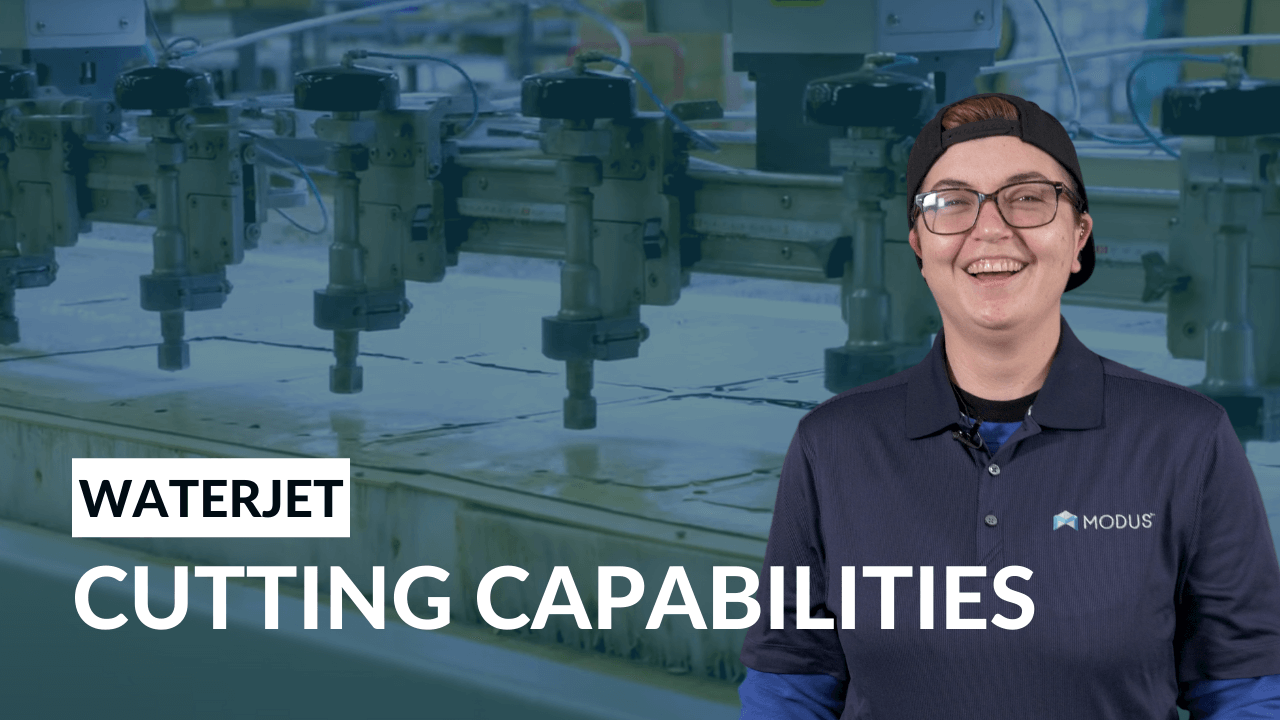
Thermal Materials and/or Microwave Absorption
Designing reliable, high-quality products that need to perform consistently in the “real world” means that your product likely needs to effectively transfer heat. In applications where direct forced air or liquid cooling is not possible, a Thermal Interface Material (TIM) is often used to transfer heat without altering a device’s physical properties or affecting performance. By choosing the correct TIM, reliability increases while failures and product returns decrease.
Selecting the right thermal product can be challenging. A good converter or manufacturer such as Modus Advanced can help you select the right process (Form-in-Place or Die-Cut), as well as the best materials for your project. Consulting with experts during the design stage can result in lower costs and better performance.
Additionally, microwave/RF absorption is a constant consideration for industries such as defense, medical, and aerospace. In the defense space, many devices rely on radio and electromagnetic frequencies to function, and interference from external signals can interfere with that function. This can mean life or death in many industries, and getting it right is the only option. Working with a partner that has a history of converting RF absorbing materials, and access to the best suppliers, is a must. This is just one of the reasons why military and defense contractors trust Modus Advanced.
Building a 10 Year Strategic Relationship
Learn how investment in building strong relationships and robust quality processes, systems and technology have driven a long-term relationship and supported the strategic growth of this telecommunications company.

Design Guidance for your CNC Machined Part
Sometimes, engineers and designers need machined parts cut and ready to go as fast as possible. Even at top speed, the goal is a minimal cost for production without sacrificing quality. At Modus Advanced, Inc., we understand those CNC machining needs. Our goal is to produce high-precision CNC machined parts as quickly and affordably as possible every day.
Our engineers have seen hundreds, if not thousands, of complex designs that span several concurrent manufacturing processes and have helped adjust them for increased manufacturability. Our DFM process has given us tremendous insight into the most common hang-ups that our partners run into during the design phase.
Let’s go over some of the most common issues our engineering team sees with the designs for CNC machined parts:
- Go for large inside corner radii: Sharp inside corners can add a lot of machine time because they may require electrical discharge machining (EDM). The tools required for EDM also add to your total cost. In general, the larger your inside corner radios, the better for your lead time.
- Don’t make pockets too deep: Keep your pocket depths to around three times the depth of the tool diameter to simplify tool access.
- Pay attention to pre-drill tapping depth: Avoid production hangups by ensuring that you’ve allowed for enough tapping depth and the drill depth necessary to produce full threads to the required thread depth.
- Avoid side work in multiple orientations: Parts that have side work on opposing faces, or faces that are 90 degrees from each other, require an additional setup to machine the part.
- Give tapped holes some wall clearance: Avoid breakout by creating more wall clearance between the tapped hole and the inside wall.
- Prefer specified edge breaks over modeled chamfers: Specifying your edge breaks can prevent machine operator errors during the CNC machining process that can cost a lot of money and time.
- For heatsinks, go wide: If possible, avoid tall fins spaced very closely together.
- Design with gasket width in mind: When possible, a wider wall is better than a thin wall, so try to design your housing with your gasket widths squarely in mind.
- Compression stops over grooves to control FIP gasket height: Avoid possible inconsistent compression forces and ineffective sealing by designing with compression stops instead of grooves.
- Instead of small o-ring grooves, use a FIP gasket: Very small O-ring grooves take a lot of time to produce, which increases costs and total lead time.
- Keep hardware to a minimum: Extra hardware in your design means extra costs and time during CNC machining.
- For quality inspection requirements, be specific: If certain dimensions in your design are going to be critical during the quality control inspection stage, specify those dimensions in your design.
- When setting tolerances, go big when possible: Larger tolerances make it easier for us to prove out the process, maintain stability and get the part back to you faster. Always choose the largest possible tolerance that still meets design requirements.
As we said, we’ve seen a lot of designs over the years. Using our proprietary SigShield™ process, coupled with a thorough DFM review, we can navigate incredibly complex and difficult parts that many traditional machine shops simply can’t contend with. With Modus Advanced, you don’t have to sacrifice quality for speed, and you certainly don’t need to bust your budget either.
Producing yourCNC Machined Part
Stage 1: Design
Stage 1 starts with the project owner (that’s you). Look for a CNC machining manufacturing partner who can handle the type of part you’re designing. Your chosen partner should be vertically integrated, have a robust DFM process, able to handle low-volume prototyping (and even actively seek it!), and can handle iterating on your design.
The earlier you can involve us in the design phase, the more we can help you build a design that will perform to your specifications, and be faster and less expensive to manufacture. Our team of engineers can also help give feedback on the overall design to make sure each component works well together, and that you can efficiently manufacture each component.
Stage 2: Prototyping Phase
Need for speed–engage. In this phase, you are rapidly testing changes in your designs and working hard to get a minimum viable product (MVP) or a prototype the way you expect. This process usually takes months, but with the right partner (like Modus) you can achieve this in weeks, or even days.
To do this, you’ll want a partner who is comfortable with small volumes and is prepared to support you on very quick turnaround parts. Many suppliers shy away from working on rapid prototyping because it is, quite honestly, a huge disruption to traditional operations focused on large-scale production runs.
Prototyping work is hard, but if we can help you get it right in this phase, we know we are poised to help you scale production (and we see that as a win for both of us!).
Stage 3: Production Phase
Next up in your product life cycle is the launch phase. This is when you are ordering small initial runs of the product to get it out into the field to initial users, or even for user testing. You zero in on speed to market and focus on the per-product cost to produce each item. Having a vertically integrated partner who can adjust production methods if needed is crucial.
As you shift a product from early launch stages to ongoing production, your primary goal will shift toward reducing unnecessary costs and finding the most efficient way to produce your final product.
This is where most suppliers want to live regularly, and how they’ve structured their operations. And this is why it is so hard to find a great supplier that can do this well and still deliver prototype runs as fast as you’d want. For example, you may find when prototyping a custom gasket or thermal pad that CNC cutting may be the best fit to get small volumes across the finish line fast. As you shift that same gasket into large-scale production, you may find that die cutting might be the best fit to reduce cost in your high volume needs.
When we work with our customers in this phase, we often provide quotes with varying options for trade-offs between lead times and costs, so you are able to choose the option that favors what is most important to you.
Vertical Integration Alleviates Production Delays
Learn more about how Signal Hound was able to overcome six months of production delays by finding a manufacturing partner that offered vertical integration.
-1.png)
What to Expect from YourCNC Machining Partner
Choosing a CNC machining partner may seem simple at the onset, however, this partner is the one who will bring your life-changing product design to realization. At the very least, your manufacturing partner should be able to meet your volume needs and be able to turn your parts around when you need them to.
If your part is complex and requires concurrent processes, you must engage with the right manufacturing partner that checks all the boxes. Plenty of manufacturing shops say they can do just that, however, we’ve seen enough letdowns to know that it isn’t always the case.
Before you start working with a CNC machining partner, consider this extensive list of what to expect from your CNC machining partner:
- Vertical integration: Pick a partner that provides a strong degree of vertical integration. It’ll save you money and time, and you won’t be pulling your hair out to get to the finish line.
- Multiple supported manufacturing processes: Ensure that your partner has expert skills in each of the manufacturing processes you require for your part. Your goal here is to consolidate as many processes under one roof as possible.
- Fast quoting and Design for Manufacturability (DFM) Reviews: DFM process should be built into the quoting process and you should have direct access to the technical staff who completed it. You should also expect to get quotes back within 24 hours when possible, or 48 hours when they must rely on a material supplier or another party to complete the quote.
- Defined goals for on-time delivery and quality: Look for registry certifications like ISO9001, high-quality ratings, published quality metrics, and robust quality feedback systems.
- Specialized materials and manufacturing experience: Look for a partner that has honed their skills. It will also ensure they’ve got the expertise to provide appropriate design feedback so you don’t have to worry about costly redesigns down the line.
- Transparency and dependability: Your dealings with team members will tell you most of what you need to know about the company as a whole in this aspect.
- Support for Prototype or production volumes
- Up-to-date systems and processes: Expect your manufacturing partners to have up-to-date Manufacturing Execution Systems (MES), Enterprise Resource Planning (ERP) systems, and Quality Management Systems (QMS).
This may seem like a list that is entirely too long, but every bullet point has a weight that adds up to a successful partnership between you and your CNC manufacturing partner of choice.
At Modus Advanced, we make it easy for our partners. We meet and exceed these expectations and strive to be better than we were yesterday. That means actively engaging with our partners to build trust and transparency. We seek out complex designs that challenge us to work hard, work smart, and work fast.
CNC machining is a deeply diverse category of machining. We hope that this guide has given you the knowledge to seek out the right partner for your CNC machined parts. If you’re interested in working with a vertically integrated partner who can complete concurrent processes under one roof to bring your complex designs to life, request a quote today.